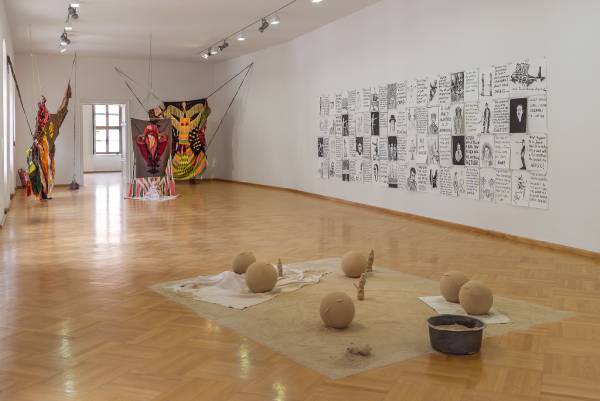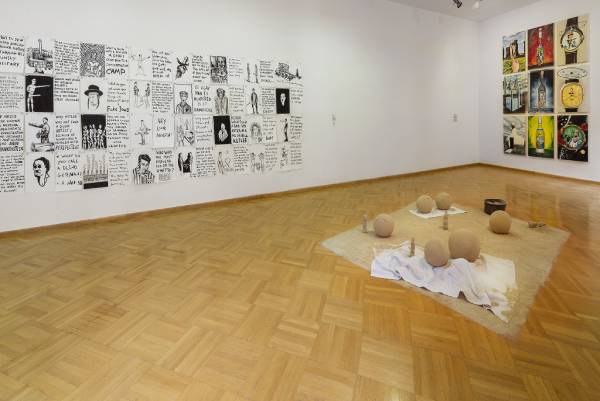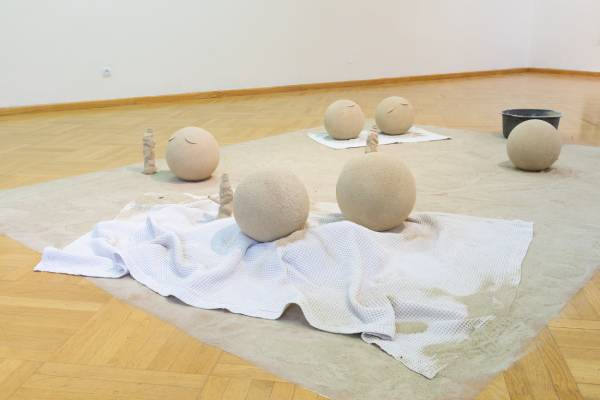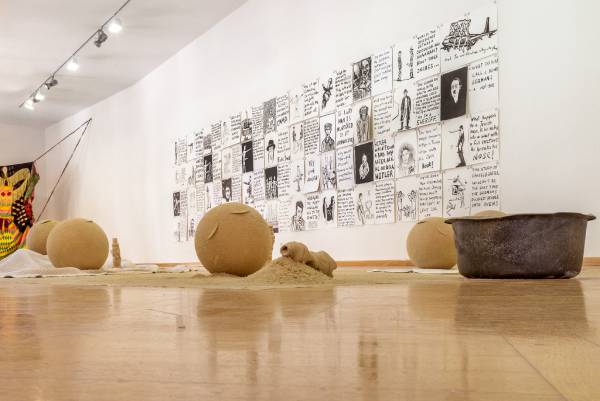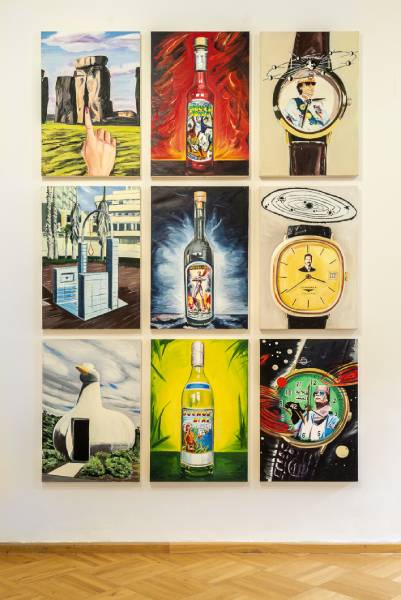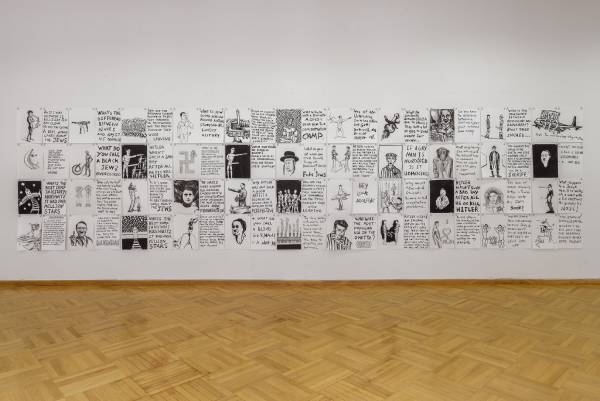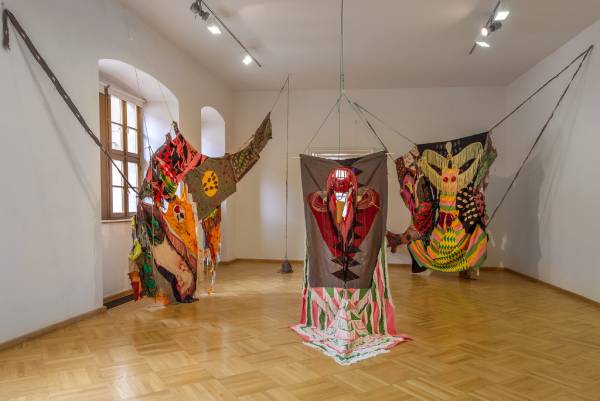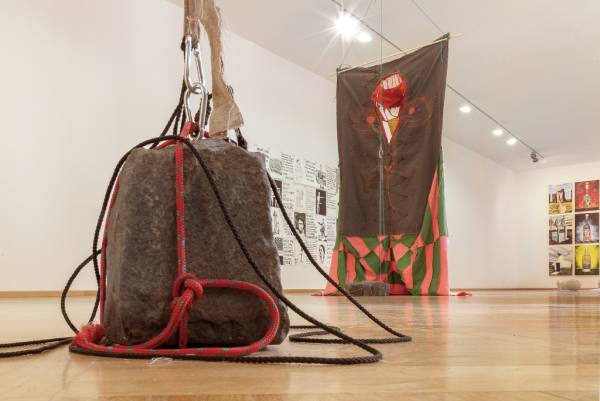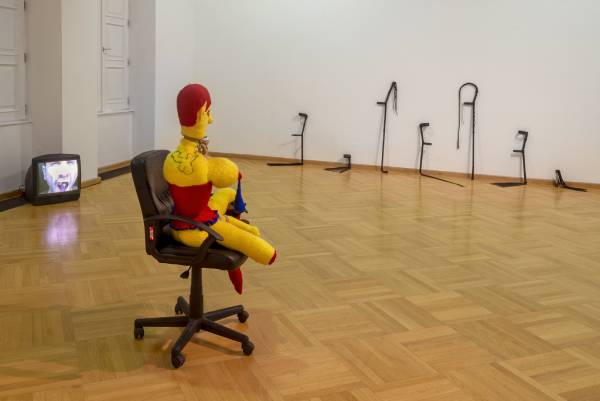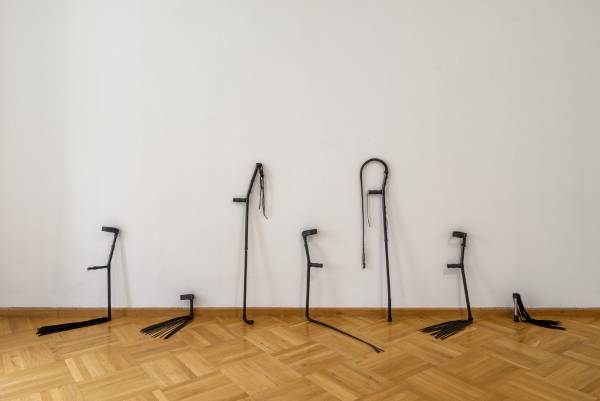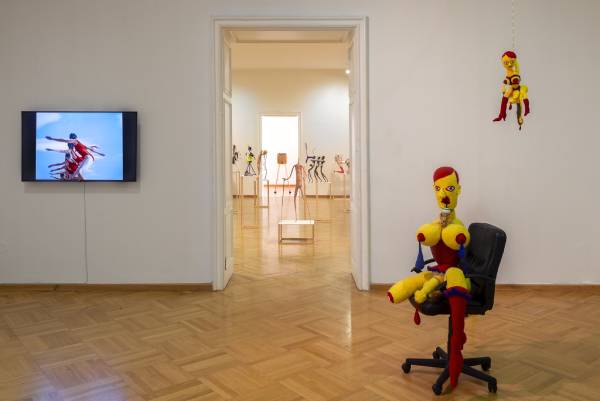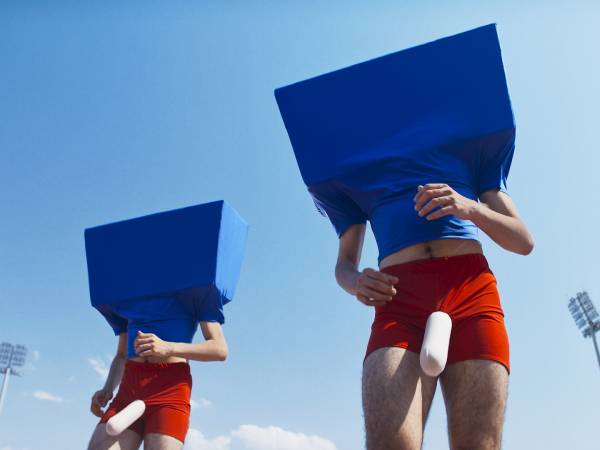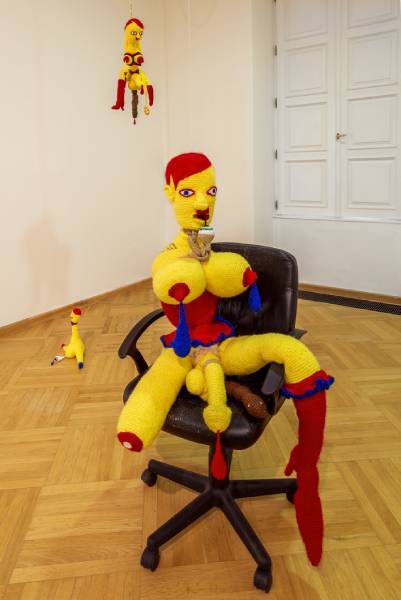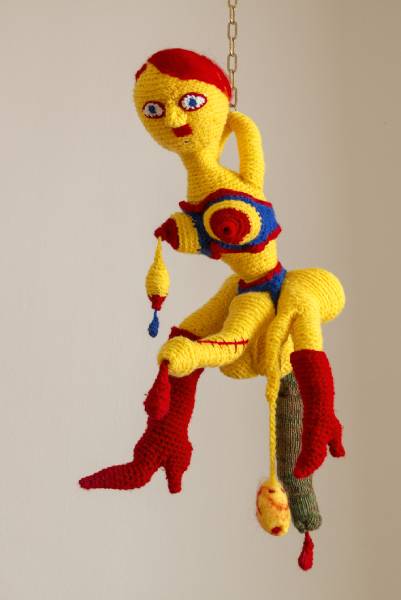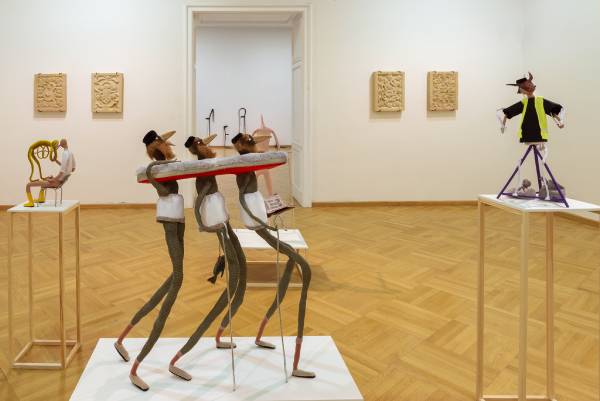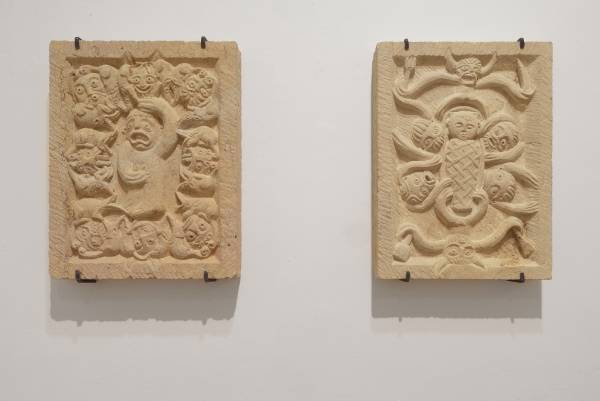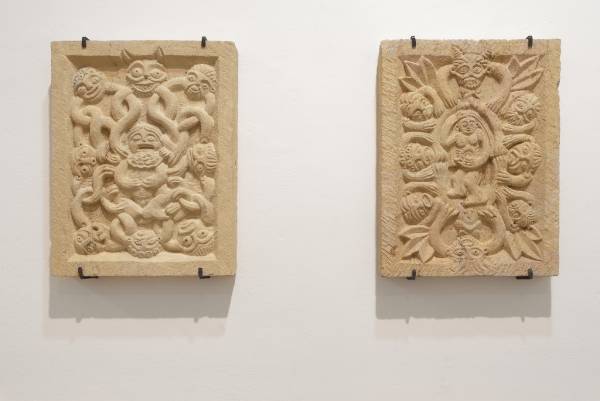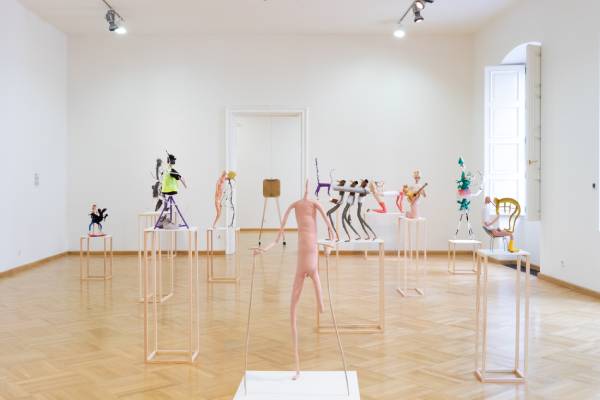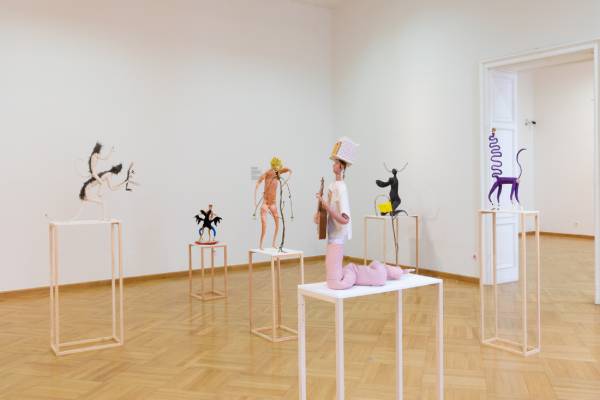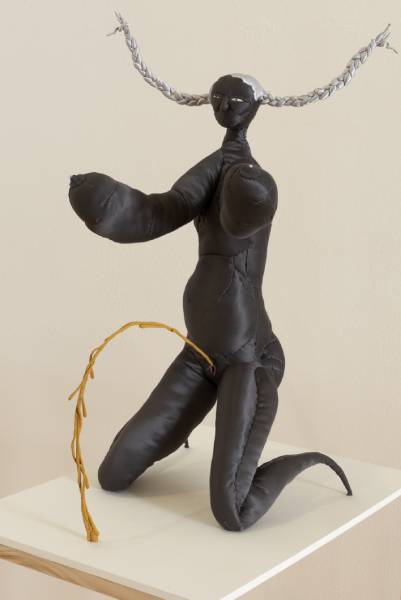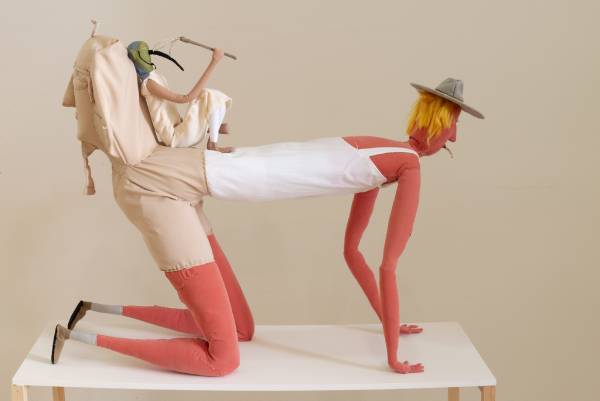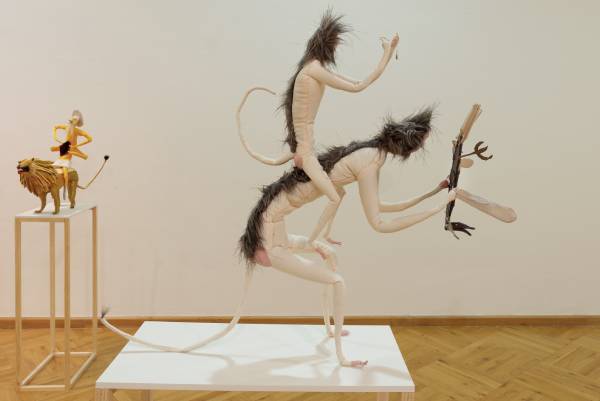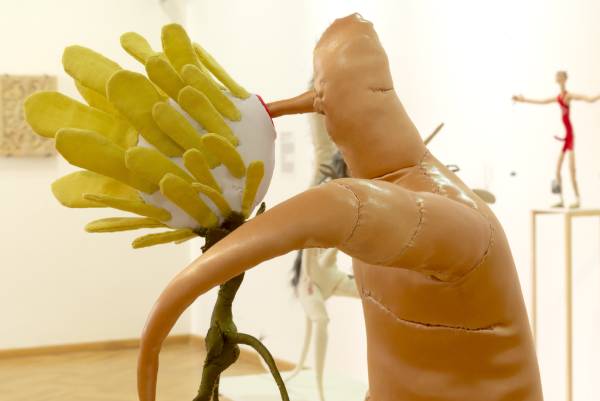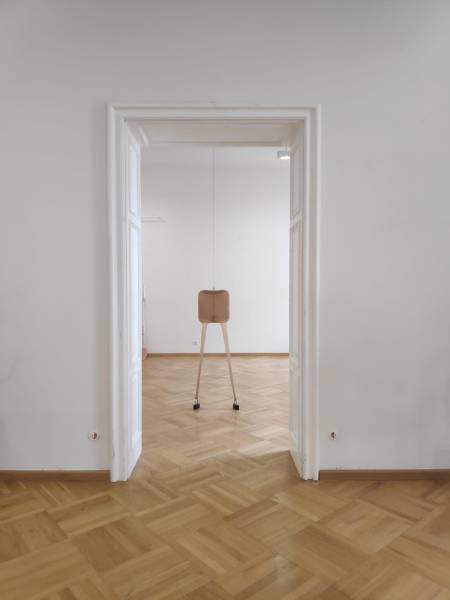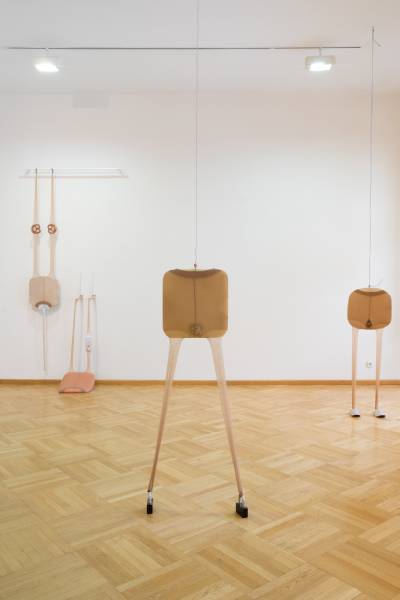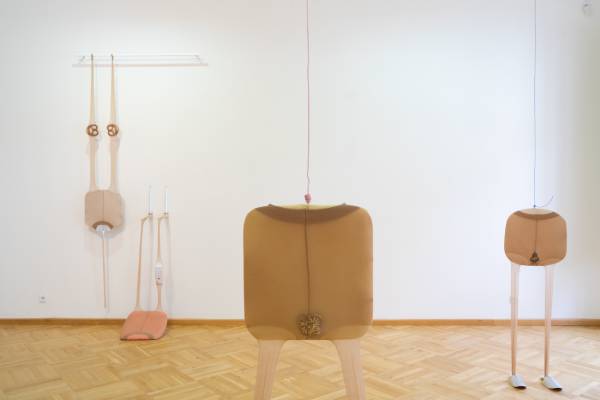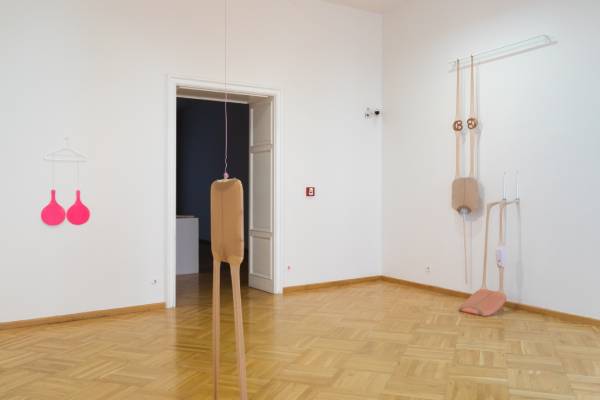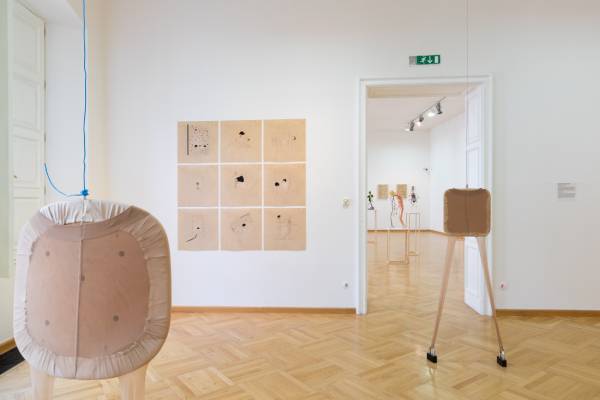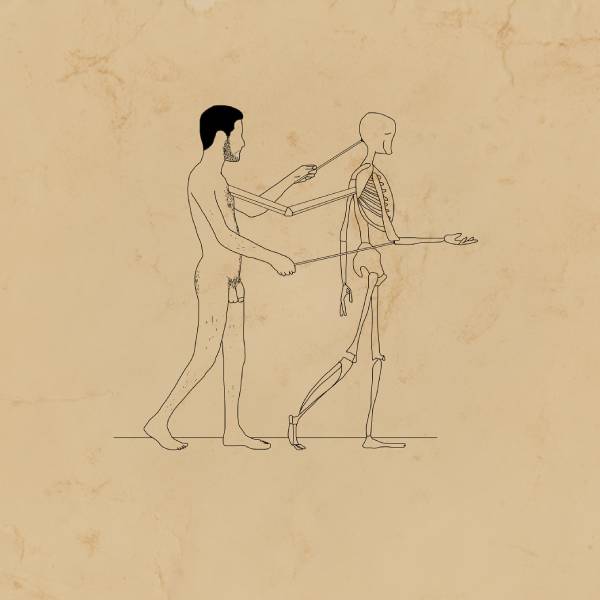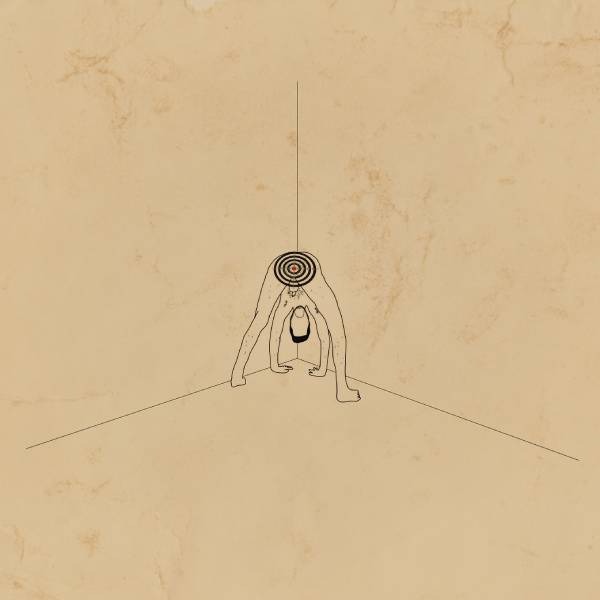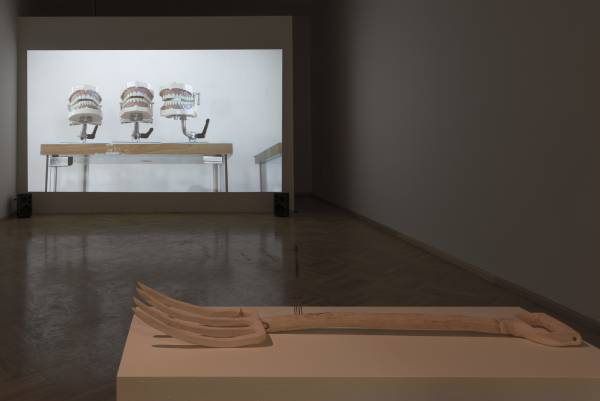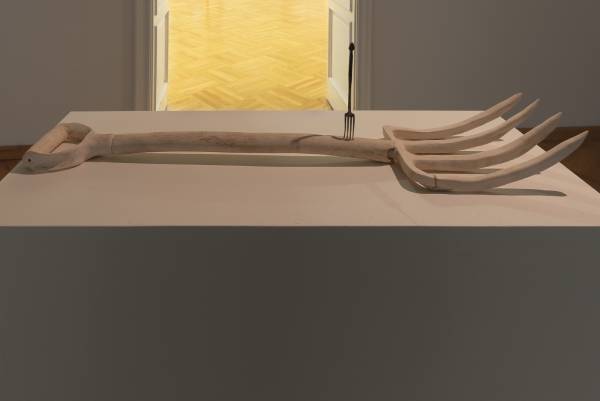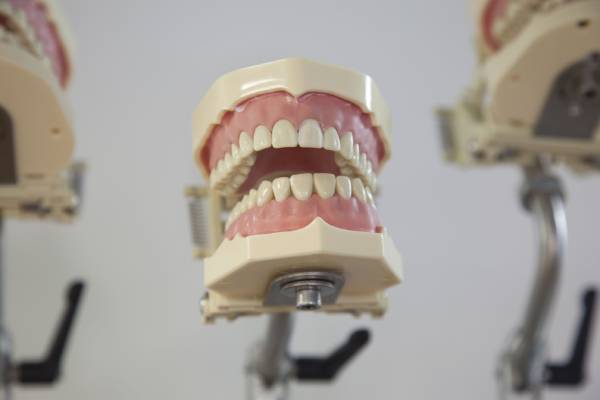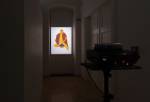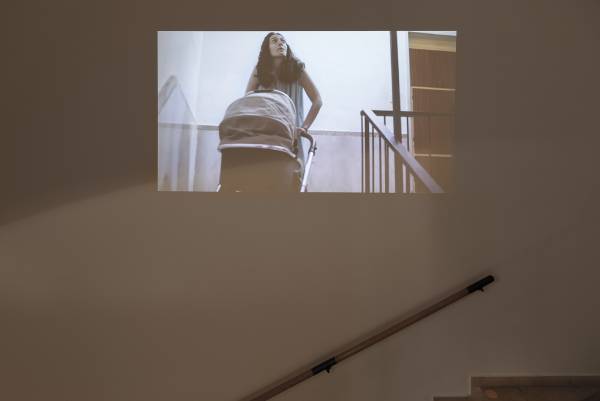Drop Dead Funny
Naama Arad/ Yaron Attar/ Gili Avissar/ Merav Kamel & Halil Balabin/ Yael Frank/ Zohar Gotesman/ Erez Israeli/ Elad Larom/ Roy Menachem Markovich/ Daniella Meroz/ Karam Natour/ Dov Or Ner/ Eran Nave/ Gil Yefman/ Yaara Zach
The Brno House of the Lords of Kunštát
September 11 - November 3, 2019
Ever since the avant-garde movements of the early twentieth century, humor and parody served as a central tool for subverting the accepted norms of society. As seen in Dada especially, but also in Surrealism, Dada’s less politically-minded offshoot, manifestations of irony, wit and nonsense abound – a response to a bourgeois social order that, following the First World War, deceived a whole generation. Rife with visual and textual gags, double meanings and pop-cultural references, the artistic legacy of these early avant-garde movements persisted into the Pop Art of the 1960s, making a strong reappearance in the postmodern art of the 1980s and 1990s – this time more daring, distorted and grotesque than ever. To name just one prominent example, the Swiss duo Fischli and Weiss, active since the late seventies, made liberal use of comical gestures which, rather than release tension, push absurdity to new heights.
Exploring such tendencies in contemporary art from Israel, Drop Dead Funny brings works in various media by 16 artists who apply humorous gestures as a way to cast a fresh look on day-to-day life and a political reality in a country rife with tensions and conflicts. A highly effective tool, humor allows them to tackle the tensions around race, gender, identity and social conventions as these intermingle with the fears and anxieties of modern life. In turning to slapstick, practical jokes, black humor, parody and the grotesque, they highlight the gap between lived experience and media representations, pointing to unresolved tensions and instilling in a sense of unease that lingers far beyond the punch line.
In a sense, resorting to humor can be seen as coping mechanism in a charge political climate, as an outlet for tension release in a public discourse governed by political correctness on the one hand and worn-out truisms and platitudes on the other – both signaling a form of censorship, weather exterior or self-imposed. As room for defiance and provocation grows increasingly tight, humor remains an effective way of puncturing the accepted image of reality, as a way of exposing it, instead, in its inherent absurdity. Taking aim at such representations, the artists in the show manage to shake off the self-complacency of the here-and-now, but also that of national histories, real and imagined, as projected unto the present.
In terms of the techniques used, the modes of representation and the genres they take inspiration from, the works in the show present a strong tendency toward the figurative and dramatized reenactment, with characters or the anthropomorphism of inanimate objects. They opt for media associated with low-tech devices and laborious handiwork, such as stop-motion animation, knitting and sewing. The style and visual signifiers draw on graphic design, illustration and cinematic genres in a mix of high and low cultural signifiers that, likewise drawing on history, literature and philosophy, create cultural hybrids meant to put humor into action as a subversive tool that dismantles hierarchies.
In poking fun at them, humor has the potential to expose the powerful mechanisms that underpin the constructs and beliefs that we take for granted. Humor’s cathartic release does away with the propaganda aspect of ideological utterances, foregrounding issues that are unspoken and protected under a seal of authority and sanctity. Once divested of their vested authority, we can begin to think of alternative to the widely-held notions and ideas that govern our current socio-economic situation.
Sally Haftel Naveh
Naama Arad
Legally Blonde (2017), chair seat, nylon tights, telephone cord, electrical cable, padlocks, dimensions variable
Eating Disorder (2017), pizza peel, nylon tights, pretzels, dimensions variable
My Hips Don't Lie (2017), chair seat, nylon tights, soap dispenser, shelf brackets, dimensions variable
Black Ice (2017), chair seat, nylon tights, air freshener, electrical cable, ice scoops, dimensions variable
Bo-Ba (2017), clothes hanger, rope, beach rackets, 93x48 cm, Courtesy of Sommer Contemporary Art Gallery
Belonging in a larger series titled “Full Frontal,” this body of work by Naama Arad explores common perceptions of the human body through a series of hybrid structures. Made from day-to-day commodities such as pantyhose, chair seats and electric cables, the disparate parts are combined in a rather a blunt and straightforward fashion, evoking the many restrictions imposed on women’s bodies as well as the constant need to accommodate oneself in search of approval. Recalling a wealth of artistic precedents from Dada on – such as Marcel Duchamp’s oversimplified readymade contraptions or the seated apathetic nudes of Sarah Lucas – Arad’s “female machines” present themselves as ironic stand-ins for an actual female presence, at once submissive, desirable and in a perpetual state of tension. The playfulness of the various juxtapositions distinguishes each of the pieces as its own visual-semantic realm, open to further associations. At the same time, the mechanical aspect brings to mind a dystopian reality of gender relationships – as the one found in Ira Levin’s 1972 satirical novel The Stepford Wives, where it turns out that the women of an idyllic Connecticut suburb were transformed into robots so that they give up any professional ambition they previously had.
Yaron Attar
The Fork Killed the Pitchfork (2018), clay and metal, 86x24x5 cm, Courtesy of Raw Art Gallery
Working in painting, sculpture and video, Yaron Attar zooms in on occurrences he sees or orchestrates in the world around him – minor lapses, mishaps, collisions and coincidences that seem to foreshadow darker undercurrents about to erupt. In his sculptures, the charged momentum is transposed to common objects that are entered in situations of strife and conflict, often verging on the absurd. In The Fork Killed the Pitchfork, Attar’s work in the show, two common appliances that share the same basic functionality are pitted against one another – a metal fork and its outsized relative, a pitchfork that has been recreated in clay. While belonging to the same family, here the smaller fork prevails, its delicate teeth stuck into the pitchfork’s most vulnerable spot, his fragile ceramic neck. With the pitchfork lying face up, defeated, and the fork balanced on top, it is clear that the power balance in the situation was determined not by size or force, but rather strategy. An evocative image of counter-balance in its own right, the confrontation of the two brings to mind an ancient proverb or biblical tale illustrated in matter.
Gili Avissar
Lady with a Fish (2017), fabric, ropes, paint, concrete tiles, dimensions variable
Devils of Unreason (2017), fabric, ropes, paint, concrete tiles, dimensions variable, Courtesy of Parasite Art Platform
Working predominantly with textiles, Gili Avissar creates large-scale sculptural assemblages in a constant state of flux, continuously evolving from one work to the next. As scraps of fabric, intricate weaves, ropes and appliqué work from previous pieces are incorporated into new ones, materials unravel and coalesce in new arrangements, entering a unique dialogue with the space. The essential fluidity of Avissar’s work process carries over to the fleeting identities suggested by these arrays of reworked fabric – vacillating between the beastly and humane, male and female, veiled identities and instances of exhibitionism. Evocative of patched-up stage outfits or the worn-out theatrical set of a nomadic troupe, Avissar’s reassembled pieces always retain their performative associations, like dormant stage props waiting to be re-activated. (In some cases, pieces do play a part in videos or live actions that he orchestrates.) Demonstrating his surreal inventiveness and a strong sense for colors, textures and the carnavalesque, Avissar’s fantastic environments nonetheless evoke a charged poetical atmosphere in how they relate to the body – or more specifically to the absence of an extravagant character who would have paraded about, tasked with
Merav Kamel and Halil Balabin
Naked Leg (2019), fabric, acrylic stuffing, metal wires, dimensions variable
The fabric dolls of Merav Kamel and Halil Balabin, two artists who have been working together since 2013, represent an array of topics spanning the biographical, current events, mythology and the history of civilization. Varying in size, these lanky figurines are sewn and crafted by hand and appear solo or in ensembles – mostly personifications, but sometimes monstrosities or beasts. By way of their medium, they conjure the innocence of handmade ragdolls and the world of childhood – attributes which they still retain, thanks to the suppleness of forms and the gentle shaping of bodies; yet the situations they enact place them in the realm of the vulgar, the hyper-sexualized and overtly-political. Walking in the footsteps of Mike Kelley and Louise Bourgeois – artists who have mined the sarcastic potential inherent in the amorphous shapes of stuffed dolls – Kamel and Balabin are able to dabble in controversy and obscenity with considerable wit, playfulness and lyricism. Their installation in the show brings together a selection of characters from their overall body of work – a crowded ensemble evoking an erratic mixture of hopes, entanglements, fears, desires and shortcomings, all looked at with great empathy.
Yael Frank
A Problem (2018), single-channel video, full HD, 4 mins, looped
Working in video and installation, Yael Frank produces works that seem witty on first impression, yet they hammer their message in so adamantly that the punchline is defeated, souring instead into a sense of unease. In A Problem, a video created in stop-motion technique, she stages a speech that centers on some distant yet clearly fictional geo-political entity, a place unfortunately plagued by recurring political unrest. In contrast with the pleading yet authoritative tone of the wording – an attempt to supposedly enlist the listener’s earnest help and attention – the text is put in the mouth of a trio of dental jaw models, which deliver it from their place on a glass cabinet of dental supplies shop. Their address is pompous but at the same time empty, nothing more than an agglomeration of worn-out clichés. Nonetheless, it contains its own undoing, with a self-referential cyclicality that already anticipates the listener’s non-action as regards the said “problem”. Along with the verbose tone of the delivery, the jaws assume gigantic proportions when projected on the wall, eliciting an absurdity that owes as much on the theatre of Brecht and Beckett as it does to the cheerful puppeteering of The Muppet Show.
Zohar Gotesman
They're Coming (to rape our woman) (2019), sand stone, 40x53x8 cm (each)
Working in traditional sculptural styles and techniques, Zohar Gotesman uses a range of materials – from stone and wood to horse manure and cheese – in ways that bring into clash the artistic traditions of the past with the present. For his current series, he immersed himself in a pictorial research of anti-Semitic representations across the ages, from medieval artifacts to present-day caricatures; such representations, he found to his dismay, still serve as a basis for spreading hate against minorities of every kind, drawing attention away from social injustices and government corruption. Isolating four major themes that still recur in racist representations across different cultures – rape, theft, kidnapping and spreading diseases – he created a series of four stone reliefs, modeled on architectonic elements from the Romanesque period. The four reliefs distill a basic iconography of hatred targeted against society’s “others” – whether of a religious or ethnic minority – which has its roots in ancient times but persists uninterrupted into the current climate of nationalist revival. Aptly appropriating the Romanesque style of medieval art, Gotesman’s hand-carved stones twist the logic of those anti-Semitic representations, pointing to their inherent danger in today’s intensifying nationalist sentiment.
Erez Israeli
Jokes (2015–2019), ink on paper, 48x72 cm each
Silence is Gold (He who laughs last laugh best) (2009), single-channel video, 1:10 mins. Courtesy of Galerie Crone
Working in a variety of media, Erez Israeli deals with issues of Jewish cultural heritage, anti-Semitic stereotypes, gender identity and the signifiers of the modern Zionist state. Since moving to Berlin in recent years, he has intensified his preoccupation with the Jewish and German past, appropriating an array of folkloric expressions and tropes to target the lingering embarrassment surrounding the memory of the holocaust. In Jokes, an ongoing series of ink drawings begun in 2015, he offers visual interpretations of Israeli and German jokes, mostly “Shoah Jokes”. Collected online, the jokes are illustrated in a crude cartoonish style whose sarcasm burdens the viewer rather than offering comic relief; this is also due to the grouping of jokes from both sides, vulgar witticisms that are otherwise intended for only one set of listeners – either Israelis or Germans, never both. A similar sarcasm is found in a short video, Silence is Gold, shot several years before. Willingly assuming the role of the ostracized, ridiculed Jew, the artist is seen pulling a row of golden teeth from his upper jaw, using a crude metal plier. Alluding to the common trope of Jewish greed and avarice, the video ends with a hollow, toothless smile.
Elad Larom
Portals and Commodities (2019), oil on canvas, series of 9, 97.5x66.5 cm each
Encompassing nine works in all, the series of painting by Elad Larom is hung in sets of three, with every such grouping containing one of each: an alcoholic beverage, a wristwatch adorned with the face of a fallen Arab tyrant, and an architectonic setting suggestive of a mystical gateway to another dimension. Enigmatic juxtapositions of images that seem to have little in common, these trios offer themselves as a visual code waiting to be deciphered – as a portal to hidden truths lying beneath or beyond, whose revelation would tie together the historic and pop-cultural signifiers encrypted therein. Larom’s loose pictorial style and vivid coloring bring to mind old-time movie posters, the covers of pulp fiction novels and other pop-cultural paraphernalia from the 1950s and 1960s, yet the subjects he depicts seem unrelated and out of place: the faces of Saddam Hussein and Muammar Gaddafi alongside sci-fi stellar constellations, colonialist conflicts reduced to comic-strip superheroes adorning the labels of liquor bottles. Equally mysterious, the real-metaphysical portals to a reality beyond – Stonehenge slabs, an odd-looking structure tiled in ceramic, or an outsized duck with a frontal entryway – seem to counterbalance the condensations of dated luxury commodities and fraught battles for cultural domination.
Roy Menachem Markovich
Suddenly (2018), single-channel video, full HD, 4 mins, looped
Joining a long list of homages to the famed Odessa Steps scene from “Battleship Potemkin,” Sergei Eisenstein’s 1925 cinematic opus, Roy Menachem’s Markovich recreates in video what is a highly charged situation that has become routine in Israel reality: the inhabitants of a typical Israeli apartment building are seen as they rush down the stairway, headed to an underground bomb shelter following a “red alert” alarm which indicates the falling of rockets in their area. However, strewn with abundant references to the soviet cinematic masterpiece, the scene turns into something of a slapstick comedy: pauses, close-ups, a baby trolley skidding down the stairs and a fallen resident trying to regain his glasses in the face of a stampeding crowd, to which Markovich added other, conventional tropes of the genre: a stumbling piano, potted plants and balloons. Panic and helplessness are transformed into what may seem as joyous chaos, yet here the comedy fails to deliver the cathartic effect. Instead, it points to the traumatic and disorienting effect of a singular catastrophe breaking through the façade of normal life – an event that, in the looped video just as in real life, is bound to repeat itself on end.
Daniella Meroz
Victory of the Rising Sun (2019), single-channel video, full HD, 10 mins.
With a title alluding to Victory over the Sun, the 1913 Russian futurist opera, Daniella Meroz’s video confronts two opposing bodily ideals as epitomized in two aestheticized spectacles staged in Germany: Oskar Schlemer’s Triadic Ballet from 1922, and Olympia, the 1938 film by Leni Riefenstahl, a documentation of the 1936 Summer Olympics in Berlin. A former actress, Riefenstahl went on to become the Third Reich’s emblematic filmmaker. In Olympia she harnessed her innovative cinematic talents toward praising the well-proportioned bodies of athletes – a “new body” in the mould of Nazi ideology; a body meant to counter an equally new – albeit grotesquely exaggerated – body that figured in the modernist art of the Bauhaus school. Schlemer’s bodies are mechanical figures, specimens adapted to a new society. Setting her video in a stadium, Meroz saddles her performers in outsized geometrical extensions that, rather impeding movement, recall Schlemer’s visual vocabulary but also the bouncy props used in reality TV. Performing synchronized drills, races or fights, performers are captured from bellow, an angle that – as with Riefenstahl – aggrandizes the body. However, Meroz allows for direct sunlight to highlight every minor imperfection, placing the scene at the threshold of success and failure, the real and ideal.
Karam Natour
The Sensual World (2016–2018), digital drawings, digital print on paper, 50x50 cm, Courtesy of Rosenfeld Gallery
The digital drawings that make up Karam Natour’s Sensual World series were created on a daily basis, in the course of two consecutive years, forming something of a graphic journal of fantastical scenes. They typically feature the artist himself, mostly nude and always faceless, together with mythological figures from classical antiquity and odd-looking contraptions or household objects – all shown in the line art style of a technical manual. With the yellowish surface of the paper support left blank and untreated, the cryptic interactions of man and machine are launched into an eerie, timeless void, further exacerbating the tension between Dionysian signifiers and the restrained, technical style of drawing. With a growing sense of enigma evolving from one scene to the next – like a surreal lexicon of highly peculiar situations – the wry humor attached to the technical style of rendering lends the drawings a sense of fantasy, of the dream-like immediacy of one’s innermost fears, passions and emotions.
Dov Or-Ner
My Friend Hitler (2006), slide projection, based on a series of 100 drawings, colored pencils on paper
From his early childhood in Paris, Dov Or-Ner was haunted by the radio speeches of Adolph Hitler, his brash intonation reminiscent of a barking dog. Born in 1927, Or-Ner lost both his parents in Auschwitz. After surviving the war, he settled in Israel, in a Kibbutz, and began studying art in his thirties, winning acclaim for his conceptual art from the 1970s on. Only at the age of 80, however, did he finally manage to spew this lifelong preoccupation with Hitler into his art. The result was My Friend Hitler, a series of 100 small-format drawings that render the Fuehrer in the cartoonish style of children’s doodles. The titular character is seen engaging in a range of activities, from the mundane to erotic self-gratification, his mostly naked body embodying everything the Nazis deemed abject and lowly: he is effeminate, degenerate, obscene. Confronted with attempts at censorship when first shown in Tel Aviv, the series opened a new and prolific chapter in Or-Ner’s art around Hitler’s character, merging victim and victimizer. For the current show, individual drawings were scanned and are beamed on the wall with a slide projector – a disturbing succession of images that is part systematic torture, part therapeutic unraveling.
Eran Nave
Longing (2019), plastic balls and bottles, glue, sea sand, towels and sheets, variable sizes
In Longing, Eran Nave’s work in the show, a number of spherical bodies are laid out on towels and other sheets in an enigmatic scene that could bring to mind a group camping out by the sea. Plastic bottles are scattered around, as well as makeshift bongs, which places the scene in the territory of a night-time, drug-induced trip. Nave, who works in a number of media, often handles ready-made objects, entering them in evocative arrangements that, with only minimal manipulation, channel the poeticism of surrealist sculpture and assemblage art. Referencing as much popular culture as earlier movements in art, however, the subconscious layers that Nave targets – a state of sleep, trance or spiritual transcendence – seem to connote the symbols and markers of youth and drug culture. At any rate, even when evoking these signifiers, it’s with a dark take. The spherical heads, so close to the all-pervasive smiley emoji or the symbol of acid trips, only have eyes to them – no more than an abstract indentation in their sandy surface. Absent of a mouth – smiling or otherwise – they launch the scene into a dark, liminal zone.
Gil Yefman
Untitled (after My Friend Hitler) (2019), acrylic yarn, acrylic stuffing, armchair, dimensions variable. Courtesy of Ronald Feldman Gallery
With his hand-knitted pieces, Gil Yefman confront us with fantastical creatures and amalgamations of body parts that overflow with sexuality, blurring the lines of gender and challenging our perception of the “other”. In Untitled (after My Friend Hitler), he takes his cue from Dov Or-Ner’s work My Friend Hitler, also on view in the show: an explosive series of colored pencil drawing from 2006 that fantasizes the totalitarian leader as an oversexualized, dubious and effeminate character. Yefman, for whom knitting is second nature, freely transposes Or-Ner’s character into a three-dimensional, life-size reality, arranging his limbs in a contorted position designed to show the degree of his sexual deviation. Echoing the familiar color scheme of Or-Ner’s series, Yefman trades his characteristic pink with a yellow contoured with red. In Yefman’s reinterpretation, however, the life-size Hitler is accompanied by two smaller yet identical figures that, partaking of the erotic activity, seem to suggest different stages in an evolution or familiar ties. The ensemble evokes the concept of auto-procreation, and, by extension, to sexual fluidity, so central to Yefman. At the same time, it brings up the much-dreaded idea of Hitler descendants – fueling conspiracy theories and urban myths in the post-war years.
Yaara Zach
Untitled (2017), metal crutches, leather whips, glue, dimensions variable, Courtesy of Givon Gallery
Connected to the body in one way or another, the ready-made objects manipulated by Yaara Zach undergo physical and conceptual transformations that turn them into sculptural hybrids, challenging our habitual approach to these objects and the categories we normally assign them to. In Untitled, her work in the show, a series of metal crutches are leaned against the wall, their edges attached with black leather whips dangling from their top or neatly spread at their feet. The combination of walking aids for the disabled with fetishistic props – objects that are both meant to come in contact with the body, yet in radically different circumstances – creates the whimsical equivocation of an extravagantly adorned medical aid on the one hand, and a toned-down, medicalized S/M accessory on the other. The subtle yet dark humor inherent in the act of re-combination nonetheless echoes to the painful absence of the body, an impression furthered the arrangement against the wall: a series of failing bodies, all lined-up, in various degrees of collapse.
Sally Haftel Naveh

